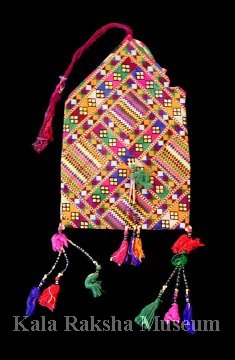|
Description
|
| MATERIALS: Cotton cloth, silk and cotton threads, tassels, strings and beads. CONSTRUCTION: Hand stitched, embroidered, satin stitches, even and uneven, sometimes worked in diagonal. Edging is done with type of braiding. MOTIFS: Geometric, bands are separated by narrow borders of black and white stripes between orange lines. Centre area is divided into four irregular rectangles of zigzag and lozenge shapes. COLOURS : Multicoloured on red. STYLE REMARKS: Fabric is completely covered by embroidering. One stitch is used in different ways to create patterns. Although only one stitch is used the patterning resembles Baluch work, which employs different stitches. For example, same borders are often done in couched work with chain stitch at edges. CULTURAL SIGNIFICANCE: Patterning is regional to Baluchistan. Baluch and Brahui both inhabit Baluchistan. Similar technique and motifs are attributed to the Hazara people of central Afghanistan who migrated from central Asia of Mongolia in 13th-14th century. However the patterning has been adapted to typical Baluch pattern. CULTURAL REMARKS: Bujki is used throughout Iran, Afghanistan, Pakistan and India. Note that peoples from Afghanistan have come as Refugees to neighbouring Baluchistan particularly in recent years. Possibly Brahui and Hazara have common history or origin. Possibly technique was brought from Afghanistan and adapted to Baluch regional style. Banjara in some regions use similar technique and motifs. Thread used is plied rather than floss. Research needs to be done on Brahui people. Bujki. |
Bagchi
-Tharparkar Regional Arts
-Copyright your Museum

COPYRIGHT INFORMATION ~ When using this image, the credit information should be in the following format: Image courtesy of the Kala Raksha Museum.

COPYRIGHT INFORMATION ~ When using this image, the credit information should be in the following format: Image courtesy of the Kala Raksha Museum.